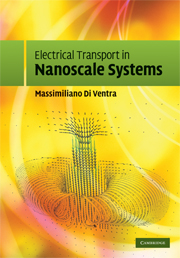Book contents
- Frontmatter
- Contents
- Preface
- 1 A primer on electron transport
- 2 Drude model, Kubo formalism and Boltzmann equation
- 3 Landauer approach
- 4 Non-equilibrium Green's function formalism
- 5 Noise
- 6 Electron-ion interaction
- 7 The micro-canonical picture of transport
- 8 Hydrodynamics of the electron liquid
- Appendices
- Appendix A A primer on second quantization
- Appendix B The quantum BBGKY hierarchy
- Appendix C The Lindblad equation
- Appendix D Ground-state Density-Functional Theory
- Appendix E Time-Dependent DFT
- Appendix F Time-Dependent Current DFT
- Appendix G Stochastic Time-Dependent Current DFT
- Appendix H Inelastic corrections to current and shot noise
- Appendix I Hydrodynamic form of the Schrödinger equation
- Appendix J Equation of motion for the stress tensor
- Appendix K Cut-off of the viscosity divergence
- Appendix L Bernoulli's equation
- References
- Index
Appendix C - The Lindblad equation
from Appendices
Published online by Cambridge University Press: 06 July 2010
- Frontmatter
- Contents
- Preface
- 1 A primer on electron transport
- 2 Drude model, Kubo formalism and Boltzmann equation
- 3 Landauer approach
- 4 Non-equilibrium Green's function formalism
- 5 Noise
- 6 Electron-ion interaction
- 7 The micro-canonical picture of transport
- 8 Hydrodynamics of the electron liquid
- Appendices
- Appendix A A primer on second quantization
- Appendix B The quantum BBGKY hierarchy
- Appendix C The Lindblad equation
- Appendix D Ground-state Density-Functional Theory
- Appendix E Time-Dependent DFT
- Appendix F Time-Dependent Current DFT
- Appendix G Stochastic Time-Dependent Current DFT
- Appendix H Inelastic corrections to current and shot noise
- Appendix I Hydrodynamic form of the Schrödinger equation
- Appendix J Equation of motion for the stress tensor
- Appendix K Cut-off of the viscosity divergence
- Appendix L Bernoulli's equation
- References
- Index
Summary
Let us consider a closed system whose degrees of freedom can be divided into two distinguishable sets – call them S and B, e.g., electrons and phonons – and we are interested in the dynamics of only one of the two, say, the electrons. Call the set of degrees of freedom S the “system”. These two sets of degrees of freedom are mutually interacting, but do not exchange particles, namely the number of particles of S is fixed.
Let us also suppose that the other set of degrees of freedom B is so large that we are not interested in its microscopic dynamics, or it is simply impossible to calculate. For both mathematical and physical reasons, by “large” I mean infinitely large. This set of degrees of freedom then acts as an environment for the system S (Sec. 1.2).
Given an initial condition, the dynamics of S + B is reversible, so that it is generated by a group of unitary operators U (t) (Eq. 1.18) on the Hilbert space of S + B, that depends on one parameter: the time t. On the other hand, if we follow only the degrees of freedom of S, by considering the environment B infinite (hence with an infinite Poincaré recurrence time – Sec. 1.2.1), we impose a preferential direction of time because, due to the interaction of S with B, during time evolution some correlations in the system S are “lost” into the degrees of freedom of B without the possibility to recover them (see Sec. 2.8).
- Type
- Chapter
- Information
- Electrical Transport in Nanoscale Systems , pp. 423 - 430Publisher: Cambridge University PressPrint publication year: 2008



